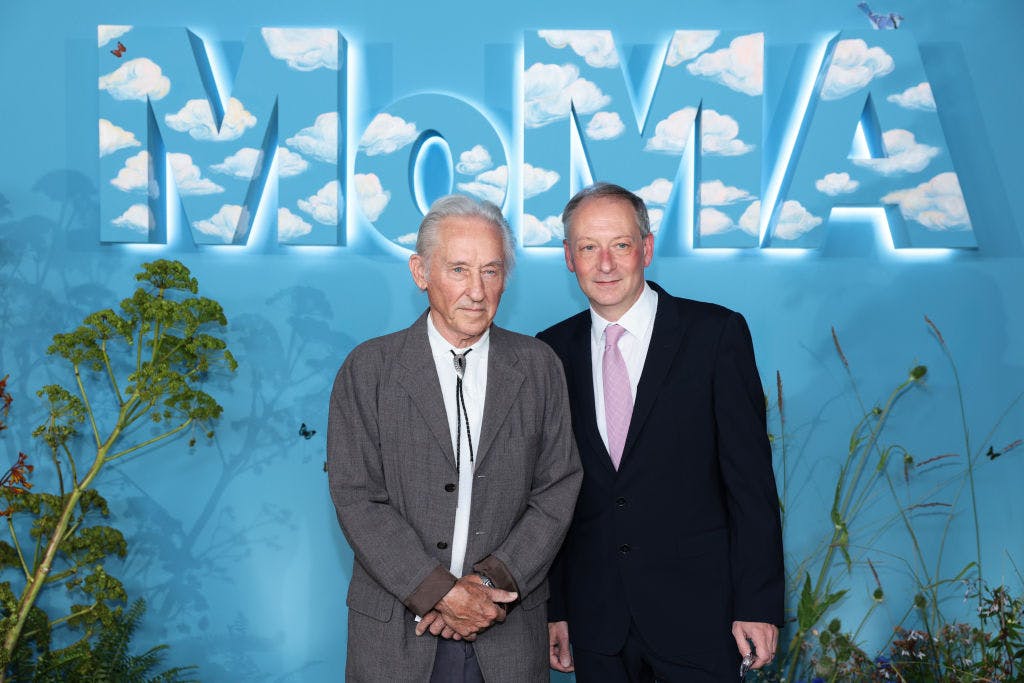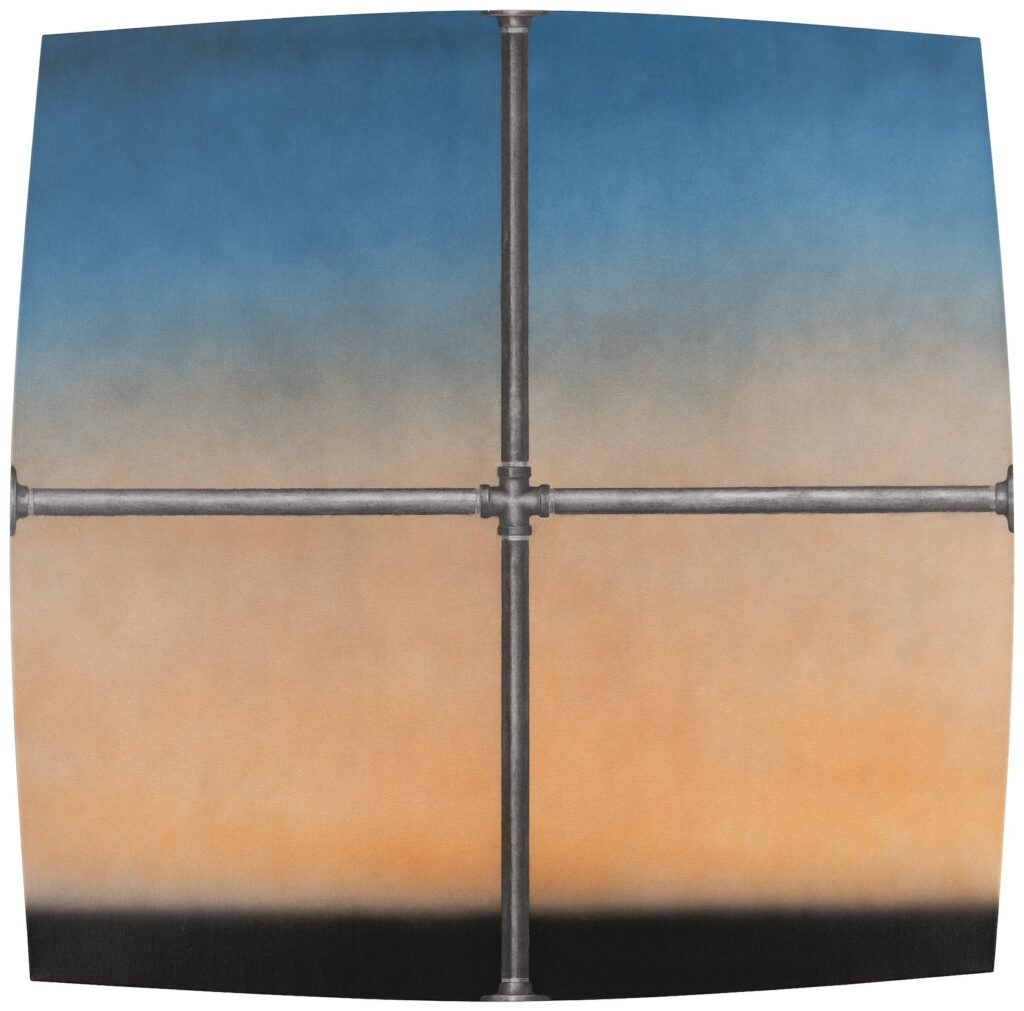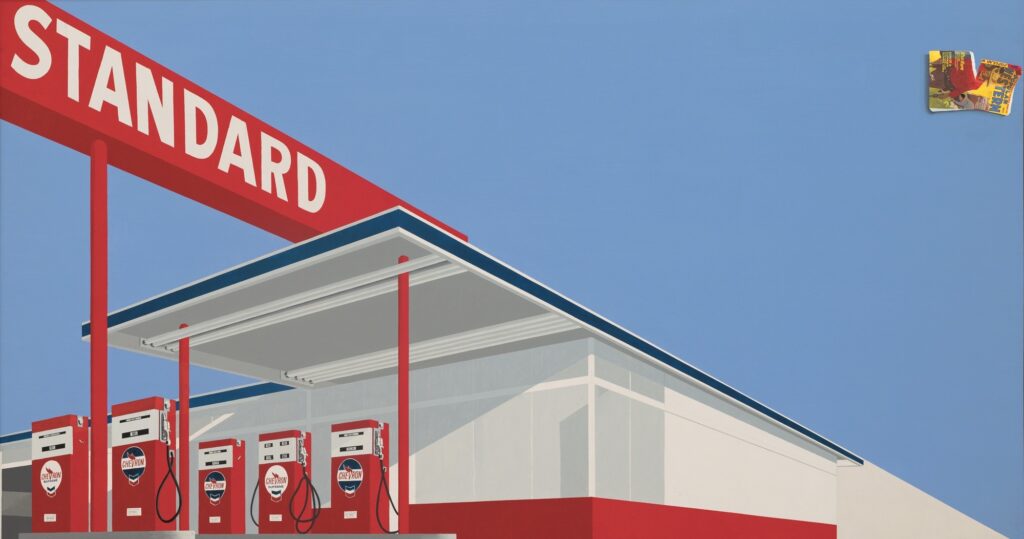A Master of California Cool Heats Things Up at MoMA
Although often associated with Pop Art, Ed Ruscha is hard to pin down, less faithful to a movement than his own idiosyncratic vision.

Ed Ruscha / Now Then
Museum of Modern Art
September 10 to January 13
Spanning more than six decades of work, “Ed Ruscha / Now Then,” which will open Sunday at the Museum of Modern Art, is a sensual and cerebral feast as well as an overdue acknowledgement of the artist’s significance and achievement. Although often associated with Pop Art, Mr. Ruscha is hard to pin down, less faithful to a movement than his own idiosyncratic vision, which spans diverse media and appearances, yet maintains a signature style of thinking.
Words and phrases, taking myriad forms, are a constant in Mr. Ruscha’s entire oeuvre. Yet MoMA opts to open the exhibition with “Charles Atlas Landscape” (2003), a wordless shaped painting featuring trompe-l’oeil metal pipes criss-crossing over a celestial background. The pipes are centered, mirroring the unseen cross bars of the stretcher underneath, and appear to push the sides of the canvas out, absurdly “pumping it up.” While non-verbal, the work is fluent in the language of painting, revealing its artifice with deadpan humor, as if to say, á la René Magritte, “these are not pipes.”

Once inside the first proper gallery, a mostly chronological overview begins with the first word paintings of the early 1960s. “Oof” is minimal and straightforward — bold yellow letters and saturated cobalt background vie for dominance in a prime example of the “push and pull” of negative and positive space. Abstract painting principles manifest in letters-as-shapes, like Robert Indiana would famously do with “Love” in 1965. Traces of Ad Reinhardt’s nearly inscrutable black-on-black musings on death and spirituality are practically mocked in “Ace,” as the titular word, rendered in commercially crisp blue italics, interrupts the somber mood with an obscene level of impasto paint.
Later in the decade, the word paintings gained increased nuance and strangeness, sometimes creating a skewed visual onomatopoeia — the text’s look not always conforming to its meaning’s expectations. In “City” (1968) the hyper-realistically painted letters appear to be made of water on a cerulean background. What is the connection here? We are left to ponder. “Annie, Poured from Maple Syrup” (1966) recreates the logo of the cartoon character as though it were rendered in goo, presaging a focus on unconventional materials in the decade to come.
Fittingly, “Chocolate Room” (1970) is next. First created for the 1970 Venice Biennale, the work is a multi-sensory environment, a room covered in hundreds of sheets of paper that have been screen printed with the aromatic confection. Perhaps a sendup of modular minimalist artists from the period, such as Carl Andre, or a nod to Dieter Roth’s signature substance, Mr. Ruscha here manages to eschew both the austerity of Andre and the madcap flavor of Roth, arriving somewhere in between: dryly humorous, methodical, and oddly beautiful — qualities visible throughout the retrospective.
Mr. Ruscha specializes in a fresh-eyed, yet subdued, sense of visual wonder — as though he is seeing objects, or realizing their potential, for the first time. “Twentysix Gasoline Stations,” his 1962 artist book of photos shot along Route 66, is just that. Nothing fancy, no attempt to elevate the subjects, a snapshot aesthetic — “just the facts, ma’am.” The exhibition makes clear the through-line from this photographic project into an iconic series of gas station paintings, in which the artist explores and varies the theme, painting a torn pulp novel on the otherwise immaculate surface of “Standard Station, Ten-Cent Western Being Torn in Half” (1964).

Another standout is the evocative “Course of Empire” series, also first presented at the Venice Biennale, from 2005. In it, Mr. Ruscha revisited an existing group of sober views of plain structures, the kinds of places we tend to ignore, if we notice them at all. The first paintings were rendered in black and white, and their later companions in color. The additions suggest the passage of time and unforeseen outcomes. “Blue Collar Trade School” (1992) is a widescreen painting reminiscent of the artist’s earlier graphite and gunpowder drawings. The sky is moody and bleak, the twin buildings uninviting. It’s an exquisitely “boring” image, redeemed by its seductive treatment of forms.
The followup, “The Old Trade School Building” (2005), uses an identical composition, yet adds a dilapidated chain-link fence — complete with barbed wire — to the foreground, and muted color throughout, most noticeably in the building’s windows, which have been covered up by mismatching pieces of yellowed plywood. The trade school closed a long time ago. Manufacturing jobs have left the country. Just as Mr. Ruscha’s take on Pop Art was less exuberant than his East Coast counterparts, his view of empire is subtler — and more insidious — than the overt rise-and-fall of Thomas Cole’s original series.

